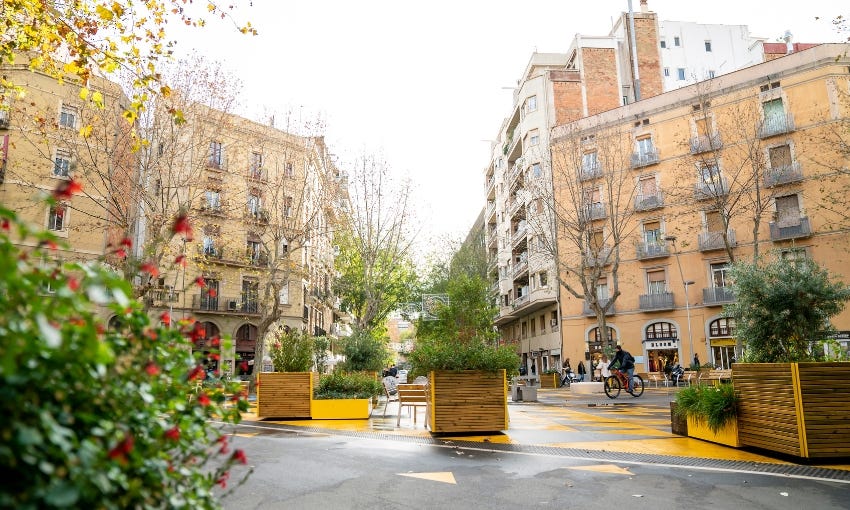Kia ora, welcome to Future Proof.
Thanks for joining me this week. Last week I shared a great interview with renowned urbanist Janette Sadik-Khan by Spinoff Wellington editor Joel MacManus: “You can reimagine streets, you can redesign them, and repurpose them to meet the needs of today, not the culture of 60 years ago,” Sadik-Khan said.
Inside the Sant Antoni superblock in Barcelona. Image credit: Ajuntament Barcelona/Flickr (CC BY-NC-ND 2.0).
Barcelona has found a way to reimagine its streets: superblocks. The city’s director of urban ecology, Salvador Rueda, recently visited New Zealand to discuss the superblock concept he’s spearheaded in a city that was once one of the most noisy and traffic-heavy in Europe.
What is a superblock?
A superblock groups together multiple smaller city blocks, often a 3x3 grid. On the streets inside the superblock, through-traffic is restricted. Cars can still enter – but they’re speed-limited and must yield to pedestrians. “It’s stupid to go in if your destination is not inside,” Rueda explains. This opens up the street space for other things – people walking and cycling, al fresco dining, and more greenery.
The idea is to rebalance transportation modes and use of street space, so it’s not solely focused on cars. “The city is like a paella. It is a system of proportions. But if you put so much salt, you can’t eat it. If you put so many cars, it’s not digestible,” says Rueda. “Cities must be for citizens, not cars.”
Superblocks are possible even in cities that don’t feature a grid structure – and they could be possible in New Zealand too: Rueda suggests Auckland’s Wynyard Quarter as an ideal place to start.
Barcelona’s superblocks pave the way
The Catalan city began pursuing the superblock concept in 2016, constructing the Poblenou superilla in 2017. A handful more have sprung up since, with plans to eventually transform the urban landscape with 503 superilles by 2030. So far, results are promising. In the Sant Antoni superblock, air quality improved and noise dropped by 4 decibels. Residents’ wellbeing has improved too: people report feeling more tranquillity, safety and satisfaction.
And while traffic reduced on the superblock’s interior streets, it wasn’t simply displaced to the perimeter – people chose not to use cars so much. “The most important network in our sites is not the road for cars. It’s the public transport,” says Rueda. He has designed a more efficient bus network that fits with the superblocks, which, once implemented, aims to have a five-minute wait time.
The shift in urban design is predicted to increase life expectancy in the city by 200 days, avoid more than 600 deaths every year, and reduce urban heat. Hundreds of thousands of trips in private vehicles are predicted to shift to public and active transport modes like buses, cycling and walking.
But city-dwellers are so much more than the way they choose to get around: “A pedestrian is a mode of transport. The citizen is something more,” says Rueda. Entertainment, art, culture and public debate become possible when public space is reclaimed from cars. “We want to see children playing in the middle of the street – but safely.”
The Spinoff and SparkLab proudly present: Business is Boring Live!
Idea to impact: Designing waste out of the systemHosted by Simon Pound, a panel of three leaders in circular business; Sara Smeath, Jayden Klinac and Rachel Brown will share their experiences of building better business systems. Join us at The Spinoff Chambers on the 30th of April for a live pod record with Q + A. Be part of the event, and part of the solution.
To secure your spot, please RSVP: commercial@thespinoff.co.nz by April 23
Government announces string of decisions that anger environmentalists
Resources minister Shane Jones has announced relaxed rules for consenting new coal mines. WWF-New Zealand called it an “absurd, selfish decision” while Forest & Bird labelled the change “environmental and climate vandalism”.
Last week, Jones – who is also the Oceans and Fisheries Minister – announced that the limit on sea lion deaths in commercial fishing nets would be scrapped, despite the species facing population decline. Just days later, the first dataset from cameras on boats revealed that wildlife captures and deaths in commercial fishing have been significantly underreported, Andrea Vance writes for The Post (paywall).
Meanwhile, the list of projects set to be included in the controversial Fast Track Approvals Bill remains shrouded in secrecy, RNZ’s Farah Hancock reports. Public submissions on the bill close this Friday.
Swiss women win legal battle over climate inaction
Europe’s top human rights court ruled last week that Switzerland had “failed to comply with its duties” to protect its citizens’ human rights by taking climate action. A group of elderly women argued that the government’s inaction put them at risk of dying during heatwaves. The ruling carries extra weight as the court’s decisions are binding for all 46 member states of the Council of Europe.
In another landmark ruling, India’s Supreme Court has expanded the scope of the “right to life” in the country’s constitution to include “protection against adverse effects of climate change”.
Right now, we need your support more than ever
The Spinoff recently estimated that the number of full-time journalists in New Zealand may have halved since 2018 Census data was published. As the media landscape continues to change, numbers may decrease again. The Spinoff is not immune to the drastic advertising slowdown impacting the sector. That’s why we’re immensely grateful to our audience for their support. To those who already support us, thank you. If you don’t and are able, we’d be very grateful if you’d consider becoming a Spinoff member or donating today.
– Duncan Greive, founder
More stories
What will climate change do to inflation and housing? Kiwibank’s chief economist explains.
Job cuts at the Department of Conservation likely to lead to loss of species, an ecology expert suggests.
Climate change viewed through the lens of the world’s top photojournalists.
Here’s how to spot five disinformation tactics used by the fossil fuel industry.
During the Little Ice Age 600 years ago, native North American societies devised new economic, social and political structures. Could these shifts offer a blueprint for adapting to a climate-altered world?
The new Catan board game features fossil fuels, pollution, renewable energy, and overpopulation.
James Shaw’s last piece of legislation – amending the Bill of Rights to include the right to a sustainable environment – was voted down last week. But he reckons it’s only a matter of time before the idea is revived and implemented.
To finish this issue, a poignant short watch about one of New Zealand’s most endangered birds, the southern New Zealand dotterel or tūturiwhatu. Unlike their northern beach-dwelling relatives, southern dotterels nest high on the mountaintops of Rakiura Stewart Island and commute down to the beach for some kai. Only 126 southern dotterels remain. The short film made by University of Otago students documents a Department of Conservation team tasked with saving the species from extinction.
Dotty for our wildlife,
Ellen
Future Proof is looking for a sponsor!
Connect your brand with an insightful exploration of environmental news, reaching influential readers committed to sustainability and staying informed about the state of our natural world. Contact commercial@thespinoff.co.nz to learn more.
Got some feedback about Future Proof or topics you’d like covered? Get in touch with me at futureproof@thespinoff.co.nz













Yes! So many benefits to better designed cities, particularly with a focus on walking and biking: climate, physical health, mental health etc. etc. Check out UC colleague Tom Logan's paper on x-minute cities: https://www.sciencedirect.com/science/article/abs/pii/S0264275122003638.